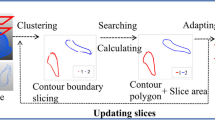Although the Slicing Method (SM) is effective for calculating the volume of point cloud objects (PCOs), it has limitations in terms of applicability and practicality due to the unforeseen circumstances and method defects. The paper proposes the Co-Opposite-Direction Slicing Method (CODSM) – an improved method which calculates the PCO volume by increasing the parallel observation (co-opposite-direction) and considering the two-way mean as the result. The proposed method fully exploits the mutual offset of random errors and the compensation of systematic directional errors, which allows effectively overcome (or mitigate) the effect of random errors and reduce the effect of systematic errors in SM. Two typical objects- a cone model and a stone lion base- are used as examples for calculating the PCO volume using CODSM. The results show that CODSM has all the inherent advantages of SM and effectively weakens the volatility of random errors and directionality of systematic errors of SM, which verifies that CODSM is a robust configuration upgrade of SM.
Similar content being viewed by others
References
H. Hillebrand, C. Durselen, D. Kirschtel, et al., J. Phycology, 35, No. 2, 403–424 (1999).
H. E. Andersen, Estimation of Critical Forest Structure Metrics through the Spatial Analysis of Airborne Laser Scanner Data (2003).
A. Benavides-Serralde, E. Hernández-Andrade, J. Fernández-Delgado, et al., The Official J. of the Int. Society of Ultrasound in Obstetrics and Gynecology, 33, No. 5, 530–537 (2009).
X. H. Wei, Y. G. Wang, J. Zheng, et al., J. Agricultural Machinery, 44, No. 7, 235–240 (2013).
A. Bienert, C. Hess, H. G. Maas, et al., Int. Archives of the Photogrammetry, Remote Sensing & Spatial Information Sciences, 45 (2014).
L. Jinsong, X. Yun, and W. Da Bala, Geoscience J. of Graduate School, China University of Geosciences, 2 (1997).
J. Liu, W. Wang, J. of Basic Science and Engineering, 23, No. 3, 430–438 (2015).
J. Douret and R. Benosman, Proc. 17th Int. Conf. on Pattern Recognition( ICPR 2004), IEEE, 3, 334–337 (2004).
J. Zhang, X. Cheng, and X. Cheng, Chinese J. of Lasers, 2016, 162–168 (2016).
H. Xie, F. Gu, Y. Li, et al., 3 D Modeling Application and Practice Based on Laser Point Cloud Data, Wuhan University Press, Wuhan City, China (2014).
J. W. Zeng, Z. R. Zhu, and R. Ding, Sci. Surveying and Mapping, 33, No. 6, 81–82 (2008).
R. J. Le Veque, Finite Volume Methods for Hyperbolic Problems, Cambridge University Press (2002).
Y. Zhi, Y. Zhang, H. Chen, et al., Int. Conf. Intelligent Control and Computer Application (ICCA 2016), Atlantis Press (2016).
B. Li, J. B. Wei, B. C. Ma, et al., Acta Geodaetica et Cartographica Sinica, 48, No. 1, 42 (2019).
B. Li, J. Wei, L. Wang, et al., Int. Journal of Remote Sensing, 40, No. 8, 3227–3246 (2019).
B. Tao, Statistical Theory and Method of Measurement Data Processing, Surveying and Mapping Publishing House, Beijing (2007).
B. Tao, J. Nanjing University Information Technology, 1, 27–31 (2009).
D. Liu, W. Liao, N. Dai, et al., J. Southest University (Natural Science Edition) (2007).
R. Pan and V. Skala, Computer-Aided Design, 43, No. 8, 896–901 (2011).
J. F. Zhu, X. Y. Hu, Z. X. Zhang, et al., Acta Geodaetica et Cartographica Sinica, 44, No. 3, 282 (2015).
R. Guo, Spatial Analysis (2nd edition), Higher Education Press, Beijing (2001).
Author information
Authors and Affiliations
Corresponding author
Additional information
Translated from Izvestiya Vysshikh Uchebnykh Zavedenii, Fizika, No. 7, pp. 103–114, July, 2021.
Rights and permissions
About this article
Cite this article
Li, B., Bi, X., Peng, C. et al. Calculation of Point Cloud Object Volume Using the Co-Opposite-Direction Slicing Method. Russ Phys J 64, 1289–1302 (2021). https://doi.org/10.1007/s11182-021-02455-7
Received:
Published:
Issue Date:
DOI: https://doi.org/10.1007/s11182-021-02455-7




